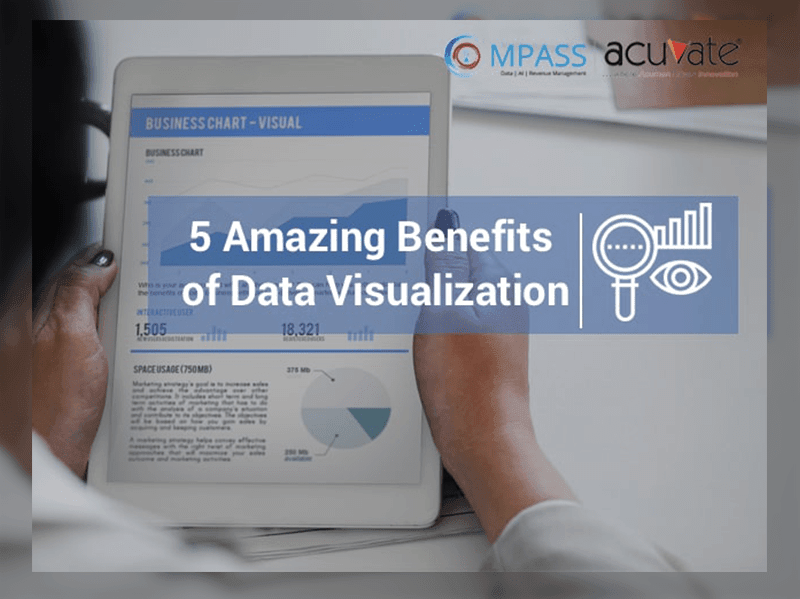Data visualization, true to its name, is the representation of data in a pictorial or graphical format, which enables decision makers to understand complex concepts, as well as identify new trends and patterns with ease. If data visualization also features interactivity which is achieved by incorporating technology, then decision makers can get down to finer details of charts and graphs, and have the ability to see data they specifically need and in a format that makes sense to them.
In this blog, we’ll delve some more into how data visualization can transform decision making in organizations.
Data Visualization Benefit 1:
Enables Swift Action
It’s common knowledge that the human brain interprets visual information far more easily than written information. Using charts or graphs transforms even the most complex data into easy to understand relationships, instead of chaotic reports and spreadsheets.
Data visualization brings about an element of simplification and transparency which allows decision makers to comprehend and take meaningful actions swiftly. Leveraging big data visualization tools ensures that business leaders are able to utilize real time information to make decisions that affect the enterprise effectively.
They’re also well-positioned to be able to adapt and respond to market changes, thereby allowing them to identify new opportunities and stay ahead of the competition in any industry.
Data Visualization Benefit 2:
Helps Organizations Identify Key Business Trends
There is an abundance of large and valuable databases that are made available to organizations today. However, this can quickly become pointless, if not harnessed and utilized efficiently. Sales and marketing teams are prioritizing using data to understand their customers and create campaigns that will resonate with them.
However, as these teams become more data driven, it’s also important to note that they do not have the same technical knowledge on extracting meaningful insights as a data scientist would. This is an obviously an impractical expectation. It would be a terrible utilization of the sales and marketing teams if they were to expend unnecessary effort on analyzing data or scanning religiously through spreadsheets.
Data visualization providers users with a swift, effective and easily accessible way to identify important patterns. This enables your sales and marketing teams to gain quick insights and make fast decisions in a competitive environment, without having to waste time on manual analysis.
CPG businesses, in particular, can really benefit from data visualization as they’ll be able to identify trends and gauge performance of their trade promotions. Sales and marketing teams will gain visibility into which product lines, promotions, retailers etc. are not doing well. This helps them identify and segment plans with accuracy and to deliver business outcomes they desire.
By integrating advanced analytics as well, sales executives can drastically step up their game and leverage real-time Data Visualization to forecast sales figures. This also enables them to figure out if a product is under performing, they’ll easily be able to figure out why. They can use this information to rework pricing, or gauge if demand has fallen, or if there are competitors offerings similar products at a better price.
Data Visualization Benefit 3:
Meaningful Interpretation of Data
Yet another benefit that big data visualization offers is a great way to interpret meaningful stories from data. For instance, you can use heat maps to follow the growth of a specific product or how it has performed over time across a variety of geographical areas.
It makes it incredibly easy for decision-makers to quickly see which products and areas are performing very well versus which ones are underperforming, so they can make the necessary changes swiftly. Big data visualization tools offer a profitable way to use data and deliver key insights that can be used to create better marketing strategies that are customized by region and help facilitate an increase in sales.
Also, they help track any changes in real time performance and make it possible to respond swiftly to market trends – an ability that is critical to organizations staying ahead of the competition.
Data Visualization Benefit 4:
Direct and Customized Interaction With Data
A key benefit that data visualization offers is enabling companies to generate customized reports and interact with data in a direct way. This helps ensures that decision makers are obtaining actionable insights. In a stark contrast to spreadsheets, tables and charts, data visualization tools offer not just viewing, but active interaction.
Also, users can easily manipulate the representation of data to eliminate what they do not require and drill down into important details.
Data Visualization Benefit 5:
Data Visualization Increases Productivity and Sales
In an Aberdeen report, it was observed that organizations that use visual data discovery tools are 28 percent more likely to find timely information than those who rely solely on managed reporting and dashboards. Needless to say, the ability to visualize data can be rather transformative for organizations in terms of real business outcomes. Not only are you enabling your employees to spend their time being more productive and work towards real business challenges instead of getting bogged down by report generation, but you’re also giving them an intelligent toolset to make better business decisions on the go.
It isn’t just sales and marketing teams that are benefited by the use of data visualization tools, but also your IT and finance departments. The study further reports that 48 percent of business intelligence users at companies with visual data discovery are able to find the information they need without the help of IT staff all or most of the time.
Businesses that have adopted data visualization tools have seen an immense increase in their ROI (Return On Investment). In yet another study of global businesses, it was observed that only 26 percent of the respondents’ organizations used data visualization. However, most of the companies that did, lead the pack in terms of revenue growth and were looking forward to continuing investing even more in data visualization in the next year.
Data Visualization in Consumer Goods and Retail Businesses
Consumer goods and retail business generate massive amounts of data at an exponential rate and from a variety of sources. Both these industries are very heavily dependent on the speed and accuracy of decision making to generate desired business outcomes. However, surprisingly, a large number of organizations from these industries still rely on manual analysis and spreadsheets to track key business metrics related to customer behaviour, trade promotions and marketing.
One of the key capabilities of our AI-Powered Trade Promotion Optimization solution – Compass is to transform real-time data (structured and unstructured data) from various internal and external sources into actionable dashboards and reports with the right advanced visualizations like charts, graphs, bars etc.
Sales and Revenue Management teams can seamlessly absorb and track key metrics either on their mobile or desktop systems.
As a strategic partner with Microsoft and Birst, we leverage several advanced visualization tools to make data consumption effortless and quick. If you’d like to learn more about this topic, please feel free to get in touch with one of our experts for a personalized consultation.



